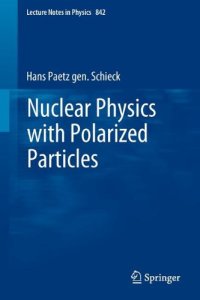
Ebook: Nuclear Physics with Polarized Particles
Author: Hans Paetz gen. Schieck (auth.)
- Genre: Physics // Quantum Physics
- Tags: Nuclear Physics Heavy Ions Hadrons, Measurement Science and Instrumentation, Quantum Physics
- Series: Lecture Notes in Physics 842
- Year: 2012
- Publisher: Springer-Verlag Berlin Heidelberg
- Edition: 1
- Language: English
- pdf
The measurement of spin-polarization observables in reactions of nuclei and particles is of great utility and advantage when the effects of single-spin sub-states are to be investigated. Indeed, the unpolarized differential cross-section encompasses the averaging over the spin states of the particles, and thus loses details of the interaction process. This introductory text combines, in a single volume, course-based lecture notes on spin physics and on polarized-ion sources with the aim of providing a concise yet self-contained starting point for newcomers to the field, as well as for lecturers in search of suitable material for their courses and seminars.
A significant part of the book is devoted to introducing the formal theory—a description of polarization and of nuclear reactions with polarized particles. The remainder of the text describes the physical basis of methods and devices necessary to perform experiments with polarized particles and to measure polarization and polarization effects in nuclear reactions. The book concludes with a brief review of modern applications in medicine and fusion energy research. For reasons of conciseness and of the pedagogical aims of this volume, examples are mainly taken from low-energy installations such as tandem Van de Graaff laboratories, although the emphasis of present research is shifting to medium- and high-energy nuclear physics. Consequently, this volume is restricted to describing non-relativistic processes and focuses on the energy range from astrophysical energies (a few keV) to tens of MeV. It is further restricted to polarimetry of hadronic particles.
The measurement of spin-polarization observables in reactions of nuclei and particles is of great utility and advantage when the effects of single-spin sub-states are to be investigated. Indeed, the unpolarized differential cross-section encompasses the averaging over the spin states of the particles, and thus loses details of the interaction process. This introductory text combines, in a single volume, course-based lecture notes on spin physics and on polarized-ion sources with the aim of providing a concise yet self-contained starting point for newcomers to the field, as well as for lecturers in search of suitable material for their courses and seminars. A significant part of the book is devoted to introducing the formal theory—a description of polarization and of nuclear reactions with polarized particles. The remainder of the text describes the physical basis of methods and devices necessary to perform experiments with polarized particles and to measure polarization and polarization effects in nuclear reactions. The book concludes with a brief review of modern applications in medicine and fusion energy research. For reasons of conciseness and of the pedagogical aims of this volume, examples are mainly taken from low-energy installations such as tandem Van de Graaff laboratories, although the emphasis of present research is shifting to medium- and high-energy nuclear physics. Consequently, this volume is restricted to describing non-relativistic processes and focuses on the energy range from astrophysical energies (a few keV) to tens of MeV. It is further restricted to polarimetry of hadronic particles.